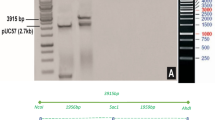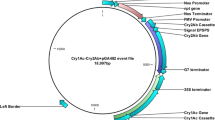Abstract
Insect-resistant transgenic cotton has been commercialized for two decades. Most of the introduced cultivars express Bt gene(s) constitutively under the control of 35S promoter in whole-plant tissues. However, there have been other promoters considered by researchers to confine the toxin expression to targeted organ and tissues. We developed a triple-gene construct including GNA, cry1Ac and cp4 epsps genes. We attempted to confine cry1Ac expression to insect biting sites by cloning it to downstream of a wound-inducible promoter isolated from Asparagus officinalis (AoPR1). Moreover, to broaden the range of resistance, GNA was driven by the 35S promoter to target the sap-sucking insects like aphids which impose large losses in cotton production. To select the transformants in selection medium and for glyphosate tolerance, GNA and cry1Ac genes were accompanied with cp4 epsps gene. Two binary vectors harboring desired genes were constructed and utilized in the study (pGTGNAoC1AC and pGTGN35C1AC). Transformation of cultivar GSN-12 was carried out by employing Agrobacterium tumefaciens strain EHA105. Plantlets were primarily screened under glyphosate (N-phosphonomethyl glycine) selection pressure and subsequently subjected to molecular and biotoxicity assays. Introduction of cry1Ac and GNA to cotton plant conferred resistance to Spodoptera littoralis and Aphis gossypii Glover. Restriction of cry1Ac toxin protein to insect biting sites along with a plant lectin attributes significantly to insect pest management strategies.




Similar content being viewed by others
References
Ahmed HAA, Onarıcı S, Bakhsh A, Akdoğan G, Karakoç ÖC, Özcan SF, Aydın G, Aasım M, Ünlü L, Sancak C, Naimov S, Özcan S (2017) Targeted expression of insecticidal hybrid SN19 gene in potato leads to enhanced resistance against Colorado potato beetle (Leptinotarsa decemlineata Say) and tomato leafminer (Tuta absoluta Meyrick). Plant Biotechnol Rep 11:315–329
Anayol E, Bakhsh A, Karakoc OC, Onarıcı S, Köm D, Aasim M, Özcan SF, Barpete S, Khabbazi SD, Önol B, Sancak C, Khawar KM, Ünlü L, Özcan S (2016) Towards better insect management strategy: restriction of insecticidal gene expression to biting sites in transgenic cotton. Plant Biotechnol Rep 10:83–94
Andow DA, Ives AR (2002) Monitoring and adaptive resistance management. Ecol Appl 12:1378–1390
Awan MF, Ali A, Muzaffar A, Abbas MA, Rao AQ, Qamar Z, Butt SJ, Khan GA, Rashid B, Nasi IA, Husnain T (2016) Transgenic cotton: Harboring broad term resistance against insect and weeds through incorporation of CEMB double Bt and cp4 epsps genes. Pak J Agric Sci 53 3:501–505
Bakhsh A, Siddique S, Husnain T (2012) A molecular approach to combat spatio-temporal variation in insecticidal gene (Cry1Ac) expression in cotton. Euphytica 183:65–74
Bakhsh A, Khabbazi SD, Baloch FS, Demirel U, Caliskan ME, Hatipoglu R, Ozcan S, Ozkan H (2015) Insect resistant transgenic crops: retrospects and challenges. Turk J Agric For 39(4):531–548
Bakhsh A, Anayol E, Khabbazi SD, Sancak C, Ozcan S (2016) Development of insect-resistant cotton lines with targeted expression of insecticidal gene. Arch Biol Sci 68:773–780
Bates SL, Zhao JZ, Roush RT, Shelton AM (2005) Insect resistance management in GM crops: past, present and future. Nat Biotechnol 23:57–62
Blain PG (1990) Aspects of pesticide toxicology. Adverse Drug React Acute Poisoning Rev. 9:37–68
Breitler JC, Vassal JM, Catala MDM, Meynard D, Marfa V, Mele E et al (2004) Bt rice harbouring Cry genes controlled by a constitutive or wound-inducible promoter: protection and transgene expression under Mediterranean field conditions. Plant Biotechnol J 2:417–430
Brown P, Charlton A, Cuthbert M, Barnett L, Ross L, Green M, Gillies L, Shaw K, Fletcher M, (1996) Identification of pesticide poisoning in wildlife. J. Chromatogr. A. 754:463–478
Cheng X, Sardana R, Kaplan H, Altosaar I (1998) Agrobacterium transformed rice plants expressing synthetic cryIA(b) and cryIA(c)genes are highly toxic to striped stem borer and yellow stem borer. Proc Natl Acad Sci USA 95:2767–2772
Cousins YL, Lyon BR, Liewelly DJ (1991) Transformation of Australian cotton cultivars: prospects for cotton improvement. Aust J Plant Physiol 18:481–491
Curry D (2002) Farming and Food: A Sustainable Future. Report of the Policy Commission on the Future of Farming and Food. Her Majesty’s Stationery Office, London
Doyle JJ, Doyle JL, Hortoriun LHB (1990) Isolation of Plant DNA from Fresh Tissue. Focus 12:13–15
EJF (2007) The deadly chemicals in cotton, environmental justice foundation in collaboration with Pesticide Action Network UK, London. ISBN No. 1-904523-10-2
Firek S, Ozcan S, Warner SA, Draper J (1993) A wound-induced promoter driving NPT-II expression limited to dedifferentiated cells at wound sites is sufficient to allow selection of transgenic shoots. Plant Mol Biol 22:129–142
Firoozabady E, Deboer DL, Merlo DJ, Halk EL, Amerson LN, Rashka KE, Murray EE (1987) Transformation of cotton (Gossypium hirsutum L.) by Agrobacterium tumefaciens and regeneration of transgenic plants. Plant Mol Biol 10:105–116
Frutos R, Rang C, Royer M (1999) Managing insect resistance to plants producing Bacillus thuringiensis toxins. Crit Rev Biotechnol 19:227–276
Gassmann AJ, Petzold-Maxwell JL, Keweshan RS, Dunbar MW (2011) Field evolved resistance to Bt maize by western corn rootworm. PLoS ONE 6:e22629
Gatehouse JA (2008) Biotechnological prospects for engineering insect-resistant plants. Plant Physiol 146(3):881–887
Gould J, Magallanes-Cedeno M (1998) Adaptation of cotton shoot apex culture to agrobacterium-mediated transformation. Plant Mol Biol Report 16:1–10
Gulbitti-Onarici S, Zaidi MA, Taga I, Ozcan S, Altosaar I (2009) Expression of Cry1Ac in transgenic tobacco plants under the control of a wound-inducible promoter (AoPR1) isolated from Asparagus officinalis to control Heliothis virescens and Manduca sexta. Mol Biotechnol 42:341–349
High SM, Cohen MB, Shu QY, Altosaar I (2004) Achieving successful deployment of Bt rice. Trends Plant Sci 9:286–292
Hussain T, Bakhsh A, Munir B, Hassan S, Rao AQ, Shahid AA, Rashid B, Husnain T (2014) Mendelian segregation pattern and expression studies of insecticidal gene (cry1Ac) in insect resistant cotton progeny. Emir J Food Agric 26:706–715
Jaakola L, Pirttila AM, Halonen M, Hohtola A (2001) Isolation of high quality RNA from Bilberry (Vaccinium myrtillus L.) fruit. Mol Biol 19:201–203
John ME (1997) Cotton crop improvement through genetic engineering. Crit Rev Biotechnol 17:185–208
Khabbazi SD, Bakhsh A, Sancak C, Özcan S (2016) Molecular Characterization of Snowdrop Lectin (GNA) and its Comparison with Reported Lectin Sequences of Amaryllidaceae. Czech J Genet Plant 52(3):94–100
Khan GA, Bakhsh A, Riazuddin S, Husnain T (2011) Introduction of cry1Ab gene into cotton (Gossypium hirsutum) enhances resistance against lepidopteran pest (Helicoverpa armigera). Span J Agr Res 9:296–300
Kiani S, Mohamed BB, Shehzad K, Jamal A, Shahid MN, Shahid AA, Husnain T (2013) Chloroplast-targeted expression of recombinant crystal-protein gene in cotton: an unconventional combat with resistant pests. J Biotechnol 166(3):88–96
Kim S, Kim C, Li W, Kim T, Li Y, Zaidi MA, Altosaar I (2008) Inheritance and field performance of transgenic Korean Bt rice lines resistant to rice yellow stem borer. Euphytica 164:829–839
Kumar M, Shukla AK, Singh H, Tuli R (2009) Development of insect resistant transgenic cotton lines expressing Cry1EC gene from an insect bite and wound inducible promoter. J Biotechnol 140:143–148
Latif A, Rao AQ, Khan MAU, Shahid N, Bajwa KS, Ashraf MA, Abbas MA, Azam M, Shahid AA, Nasir IA, Husnain T (2015) Herbicide-resistant cotton (Gossypium hirsutum) plants: an alternative way of manual weed removal. BMC Res Notes 8:453
Liu Z, Zhu Z, Zhang T (2013) Development of transgenic cry1A(c) + GNA cotton plants via pollen tube pathway method confers resistance to Helicoverpa armigera and aphis gossypii glover. In: Baohong, Zhang (eds) Transgenic Cotton. Methods in Molecular Biology. Springer Science, New York, pp 199–210
Majeed A, Husnain T, Riazuddin S (2000) Transformation of virus resistant genotype of Gossypium hirsutum L. with pesticidal gene. Plant Biotechnol 17:105–110
Maqbool A, Abbas W, Rao AQ, Irfan M, Zahur M, Bakhsh A, Riazuddin S, Husnain T (2010) Gossypium arboreum GHSP26 enhances drought tolerance in Gossypium hirsutum L. Biotechnol Prog 26:21–25
McCabe DE, Martinell BJ (1993) Transformation of elite cotton cultivars via particle bombardment of meristems. Nat Biotechnol 11:596–598
Murashige T, Skoog F (1962) A revised medium for rapid growth and bioassays with tobacco tissue cultures. Physiol Plant 15:473–497
Oerke EC (2006) Crop losses to pests. J Agr Sci 144:31–43
Ozcan S, Firek S, Draper J (1993) Selectable marker genes engineered for specific expression in target cells for plant transformation. Nat Biotechnol 11:218–221
Perlak FJ, Deaton RW, Armstrong TA, Fuchs RL, Sims SR, Greenplate JT, Fischhoff DA (1990) Insect resistant cotton plants. Biotechnol 8:939–943
Poulsen M, Kroghsbo S, Schrøder M, Wilcks A, Jacobsen H, Miller A, Frenzel T, Danier J, Rychlik M, Shu Q, Emami K, Sudhakar D, Gatehouse A, Engel KH, Knudsen I (2007) A 90-day safety study in Wistar rats fed genetically modified rice expressing snowdrop lectin Galanthus nivalis (GNA). Food Chem Toxicol 45(3):350–363
Rahman M, Hussain K, Khan MA, Bakhsh A, Rao AQ (2012) An insight of cotton leaf curl virus: a devastating plant pathogenic begomovirus. Pure Appl Biol 1:52–58
Ramesh S, Nagadhara D, Reddy VD, Rao KV (2004) Production of transgenic indica rice resistant to yellow stem borer and sapsucking insects, using super-binary vectors of Agrobacterium tumefaciens. Plant Sci 166:1077–1085
Rao AQ, Bakhsh A, Nasir IA, Riazuddin S, Husnain T (2011) Phytochrome B mRNA expression enhances biomass yield and physiology of cotton plants. Afr J Biotechnol 10:1818–1826
Rashid B, Saleem Z, Husnain T, Riazuddin S (2008) Transformation and inheritance of Bt genes in Gossypium hirsutum. J Plant Biol 51:248–254
Singh PK, Kumar M, Chaturvedi CP, Yadav D, Tuli R (2004) Development of a hybrid delta-endotoxin and its expression in tobacco and cotton for control of a polyphagous pest Spodoptera litura. Transgenic Res 13:397–410
Southern EM (1975) Detection of specific sequences among DNA fragments separated by gel electrophoresis. J Mol Biol 98:503–517
Stoger E, Williams S, Christou P, Down RE, Gatehouse JA (1999) Expression of the insecticidal lectin from snowdrop (Galanthus nivalis agglutinin; GNA) in transgenic wheat plants: effects on predation by the grain aphid. Sitobion avenae Mol Breed 5:65–73
Tabashnik BE, Bre´vault T, Carrie`re Y (2013) Insect resistance to Bt crops: lessons from the first billion acres. Nat Biotechnol 31:510–521
Tohidfar M, Ghareyazie B, Mosavi M, Yazdani S, Golabchian R (2008) Agrobacterium-mediated transformation of cotton (Gossypium hirsutum) using a synthetic cry1Ab gene for enhanced resistance against Heliothis armigera. Iran J Biotechnol 6:164–173
Umbeck P, Johnson G, Barton K, Swain W (1987) Genetically transformed cotton (Gossypium hirsutum L.) plants. Nat Biotechnol 5:263–266
Vajhala SKC, Sadumpati VK, Nunna HR, Sateesh Puligundla SK, Vudem DR, Khareedu VR (2013) Development of transgenic cotton lines expressing Allium sativum agglutinin (ASAL) for enhanced resistance against major sap-sucking pests. PLoS One 8:e72542
Van den Berg J, Hilbeck A, Bøhn T (2013) Pest resistance to Cry1Ab Bt maize: field resistance, contributing factors and lessons from South Africa. Crop Prot 54:154–160
Wang Z, Zhang K, Sun X, Tang K, Zhang J (2005) Enhancement of resistance to aphids by introducing the snowdrop lectin gene GNA into maize plants. J Biosci 30:627–638
Warner SA, Scott R, Draper J (1992) Characterization of a wound induced transcript from the monocot asparagus that shares similarity with a class of intracellular pathogenesis-related (PR) proteins. Plant Mol Biol 19:555–561
Wu J, Luo X, Guo H, Xiao J, Tian Y (2006) Transgenic cotton, expressing Amaranthus caudatus agglutinin, confers enhanced resistance to aphids. Plant Breed 125:390–394
Wu J, Luo X, Wang Z, Tian Y, Liang A, Sun Y (2008) Transgenic cotton expressing synthesized scorpion insect toxin AaHIT gene confers enhanced resistance to cotton bollworm (Heliothis armigera) larvae. Biotechnol Lett 30(3):547–554
Zhao JZ, Cao J, Li Y, Collins HL, Roush RT, Earle ED, Shelton AM (2003) Transgenic plants expressing two Bacillus thuringiensis toxins delay insect resistance evolution. Nat Biotechnol 21:1493–1497
Acknowledgements
The PhD. fellowship awarded by The Scientific and Technological Research Council of Turkey (TUBITAK)-BIDEB to Dr. S.D. Khabbazi is deeply appreciated. The authors are grateful to the Leicester University (UK) for giving permission to use AoPR1 promoter for research purposes, Dr. Selma Onarıcı (TÜBİTAK GMBE) for providing pJIT61.cry1Ac plasmid and Prof. Umut Toprak (Department of Crop Protection, Ankara University) for providing S. littoralis larvae.
Author information
Authors and Affiliations
Corresponding authors
Rights and permissions
About this article
Cite this article
Khabbazi, S.D., Khabbazi, A.D., Özcan, S.F. et al. Expression of GNA and biting site-restricted cry1Ac in cotton; an efficient attribution to insect pest management strategies. Plant Biotechnol Rep 12, 273–282 (2018). https://doi.org/10.1007/s11816-018-0493-8
Received:
Accepted:
Published:
Issue Date:
DOI: https://doi.org/10.1007/s11816-018-0493-8




